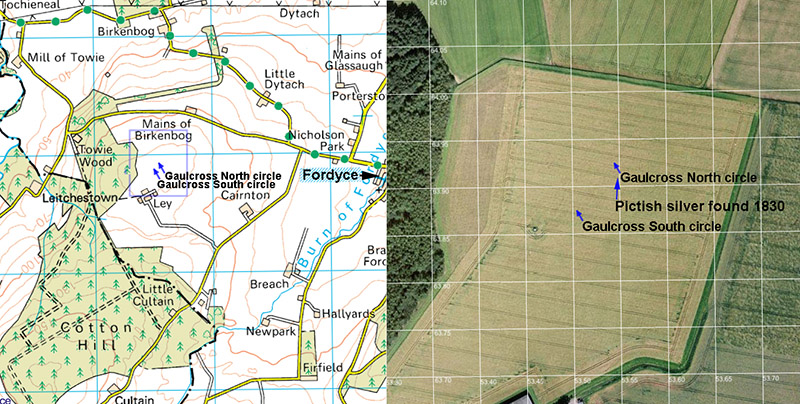| Author | Aberdeen archaeologists discover large hoard of late Roman and Pictish silver coins |
Andy B

Joined:
13-02-2001
Messages: 12543
from Surrey, UK
 OFF-Line OFF-Line
|  Posted 19-12-2014 at 17:28 Posted 19-12-2014 at 17:28

A hoard of late Roman and Pictish silver coins has been found buried in a north-east field.
More than 100 pieces of silver, coins and jewellery were discovered by archaeologists from National Museums Scotland and Aberdeen University’s Northern Picts Project.
However, the exact location in Aberdeenshire where the find was made is being kept a closely-guarded secret incase any eager silver-diggers with metal detectors tried to hunt for their own piece of treasure.
The dig was led by Gordon Noble, a senior lecturer Aberdeen University’s archaeology department.
He said: “The new finds include late Roman coins, pieces of late Roman silver vessels, bracelet and brooch fragments and other objects that would have been highly prized objects in their day.
“Our work in the north-east of Scotland is increasingly showing that Pictish communities in this area were part of powerful kingdoms in the early medieval period.”
Mr Noble described it as an “exciting new find”, and said it was part of a broader phenomenon of hacksilver hoards from across Europe from the 4th to 6th centuries AD.
He added: “Silver objects were chopped up into bullion and then used and exchanged as payment, bribes, tribute and reward.
“People buried their wealth to keep it safe, but many did not return to recover their hoard.”
Experts from National Museums Scotland will now carefully analyse, describe and catalogue each individual piece of the find – which is the most northern late Roman silver hoard ever unearthed in Europe.
Senior curator Martin Goldberg, of National Museums Scotland, said: “The research project will enable us to shed new light on the interaction between the Picts and the late Roman world and reconsider what some older finds in our collection can tell us about early medieval Scotland.
“It is a hugely important discovery being Europe’s most northerly Late Roman hacksilver hoard, and also containing otherwise unique Pictish silver.”
Elements of the hoard discovered by team will be on show from January 20 to May 31 next year at Aberdeen University’s King’s Museum.
Source:
https://www.pressandjournal.co.uk/fp/news/aberdeen/420510/medieval-silver-hoard-pict-up-by-aberdeen-archaeologists/
With thanks to Golux for the link
 Profile Profile
 Email Email
 Reply Reply
|
golux

Joined:
15-03-2010
Messages: 37
 OFF-Line OFF-Line
|  Posted 19-12-2014 at 21:21 Posted 19-12-2014 at 21:21
Thanks for posting the article Andy, I am sure others will be interested to see it. Too bad the lack of a location keeps this off the News page but the secrecy is understandable. I will be visiting the museum next month, I will try to find out when the location will be revealed.
[ This message was edited by: golux on 2014-12-19 21:22 ]
 Profile Profile
 Reply Reply
|
golux

Joined:
15-03-2010
Messages: 37
 OFF-Line OFF-Line
|  Posted 23-12-2014 at 14:41 Posted 23-12-2014 at 14:41
A BBC news report of 22nd December 2014 revealed that the hoard was discovered in March 2013 by detectorist Alistair "The Magnet" MacPherson, at Gaulcross in Aberdeenshire. The exact location is not given but described as a "former stone circle site". This suggests it is in the field lying immediately north of Ley farmhouse, about 200 meters west of the village of Fordyce, this being the home of two ring-cairn stone circles (South Gaulcross at NJ 5350 6387 and North Gaulcross at NJ 5354 6392) and also a previous discovery of Pictish silver in 1830, unearthed less than 6 meters south of the latter circle. A chain and possible buckles, pins and brooches, all of silver, possibly from the 8th century, were found as well as an urn; the brooch and a pin are now in the museum at Banff* which holds other ancient silverware because Banff was a centre for silver working in the 17th, 18th and 19th centuries.
The 2013 investigation of this site was led by Dr Gordon Noble, senior lecturer in department of archaeology, who said: "The north east of Scotland is very rich in its heritage and we've been working on a number of Pictish sites, including our work at Rhynie, which appears to be an early royal centre of the Picts . . . At Rhynie, we're actually finding metal working moulds, exactly the kind of items that would be used to make some of the items that we've found in the hoard here.''
I have posted a map of the site on the Gaul Cross stone circles page

BBC news report
Canmore record of Gaulcross North and the 1830 Pictish silver discovery
Description of the 1830 finds by R B K Stephenson and John Emery
* "Banff" is pronounced to rhyme with "amph" as in amphitheatre.
[ This message was edited by: golux on 2014-12-23 15:00 ]
[ This message was edited by: Andy B on 2014-12-23 22:03 ]
 Profile Profile
 Reply Reply
|
|






